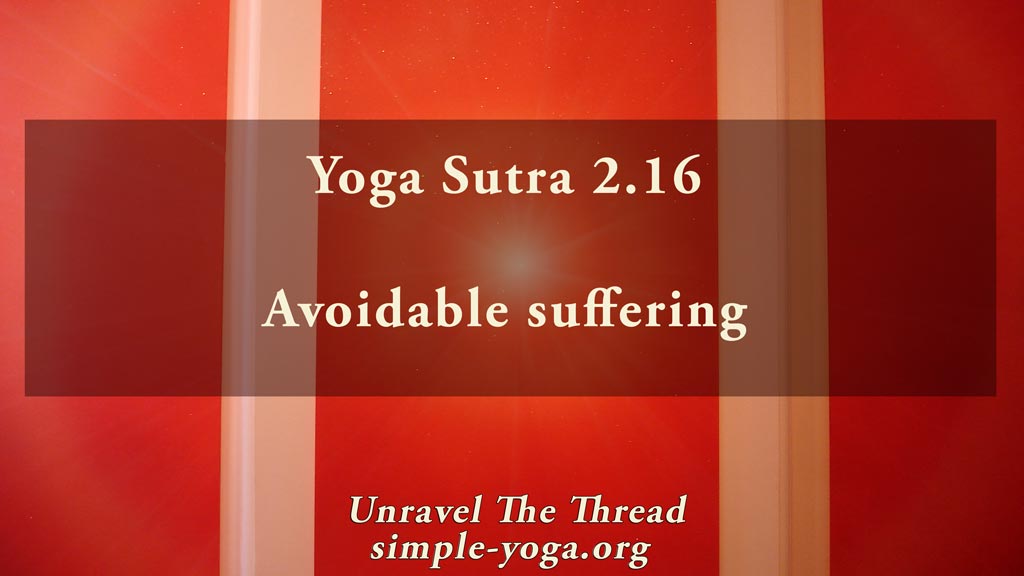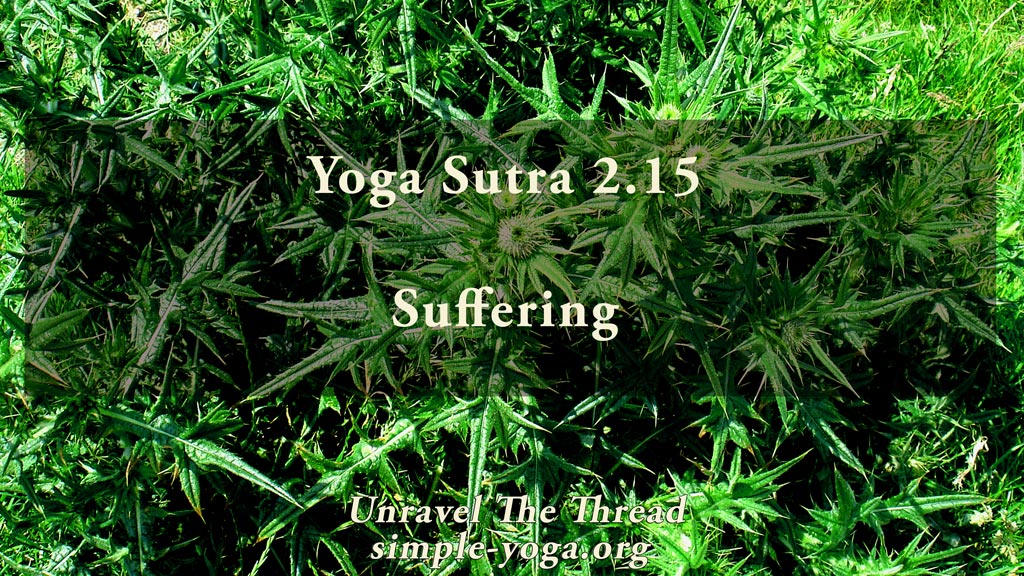2.16 Avoiding suffering

2.16 Future suffering can be avoided.
Confirming the famous anonymous saying “pain is inevitable, suffering is optional,” in this verse Patañjali states that future suffering is optional because it can be avoided. In your daily life, it may sometimes feel like you are riding an emotional rollercoaster. It takes you to the heights of exhilaration, spins you around into excitement and then brings you to the lows of pain and suffering. The emotional rollercoaster keeps going all the time. It results from allowing your internal climate to be influenced by external events and circumstances. Many of us know that a turn in the weather, depending on what it is, can make us feel sad, happy or anxious. Similarly, you may interpret somebody’s words as a reason to feel happy or unhappy. But, is it really possible to avoid suffering? Remember that there is a distinction between pain and suffering. Pain is the discomfort, soreness or ache, a sensation that you experience. Suffering is when you charge that sensation with emotion and keep dwelling on it in ways that generate distress, hopelessness and helplessness. The pain you feel is a sensation that offers you potentially useful information. Is it possible to choose what to do with that information? Is pain the result of an action, belief or opinion you hold? Is it possible that suffering results from a story that you have chosen to believe? Does your suffering originate from unwillingness to be with what is, just as it is?
Recall that even what used to be a source of happiness or pleasure can become a new source of worry, anxiety and suffering. It happens often that a person can start creating reasons to suffer just by thinking about what might happen in the future. Ask yourself this: Are you already anxious, upset or irritated by something that has not happened yet? Are there things you worried about in the past that never happened? To what extent are your expectations and predictions influencing your inner climate? Could this sutra be a helpful reminder of the message in this saying: “If your problems have a solution, why worry? And if your problems have no solution, why worry?”
One important clarification to keep in mind: This verse DOES NOT say to ignore pain, emotions, or sensations. This verse is not about becoming insensitive or unresponsive. Pain, emotions and sensations offer useful feedback, foregrounding the interrelations between your inner world and your external world in a continuous feedback loop. Rather than trying to manipulate your sensations, it may be more useful to start by recognizing that whatever you are feeling is valid, because you are feeling it. As a whole human being, you have a complete range of healthy emotions helping you navigate your life. Once you recognize what you are feeling as valid, then you can clarify if any action is needed. In fact, in yoga the goal is to sense and to feel in order to become aware through your direct experience of what is happening, without getting entangled in words, stories and drama. This clarity is instrumental to determining the most effective path of action. This verse is a reminder that anything that is alive is in constant change, and that trying to attach your sense of self, your likes and dislikes, to something that is changing will guarantee frustration and suffering. Knowing this, is it possible to choose not to suffer?
As usual, one more way of exploring the meaning of this sutra is by chanting it.
You can choose to chant it in its traditional form with some of the words coming together:
2.16 heyaṃ duḥkhamanāgatam
हेयं दुःखमनागतम् ॥१६॥
Another option is to chant each word in the sutra individually:
- heyaṃ
- duḥkham
- anāgatam
If you prefer, you may listen to the podcast:
Unravel the thread is now available as a book!
If you find Simple-Yoga.org and Unravel the thread useful, consider supporting my labor with a donation, you may also donate using PayPal or Venmo. Thank you!


